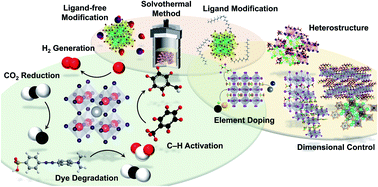Lead-free hybrid perovskite photocatalysts: surface engineering, charge-carrier behaviors, and solar-driven applications
Abstract
Lead-based hybrid perovskites have sparked substantial research interest due to the immense progress in the fields of optoelectronics and photocatalysis. However, owing to the environmental issues of lead toxicity, lead-free hybrid perovskites (LFHPs) with non-toxic metal elements, such as bismuth, strontium, etc., have attracted considerable attention. LFHPs have been recognized as potential photocatalysts because their electronic structures can be easily adjusted by tuning their chemical compositions, crystal structures, and surface morphology. In recent years, the investigation of charge-carrier behaviours on surface-engineered LFHP photocatalysts has been spurting from solar-to-fuel conversion (e.g., hydrogen evolution and CO2 reduction to CO or CH4) to some organic reactions (e.g., organic synthesis and dye degradation). Therefore, in this Review, photocatalytical fundamentals and surface engineering to enhance the charge transport and separation of available photocatalysts are firstly introduced. Synthetic methods of hybrid perovskites with resultant material properties are then discussed. Finally, the performance of LFHPs in solar-driven applications is described. According to the results achieved, current challenges and future research directions in the development of lead-free hybrid perovskites for enhancing photocatalytic efficiency and stability are summarized.



 Please wait while we load your content...
Please wait while we load your content...